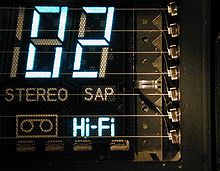Fluorescent display
A fluorescent display , also known as vacuum fluorescent display or digitron display ( English Vacuum Fluorescent Display , abbreviated as English VFD ) is an electron tube and is based on the glow of certain materials (i.e. fluorescence ) when these electrons hit them .
Working principle
Vacuum fluorescent displays are built up between a transparent pane of glass and a rear base plate, which is usually also made of glass. The plates are connected to the edge with glass solder or glued together, the display system in between is in a vacuum . A thin tungsten heating wire coated with oxides is stretched in front of the light segments forming the anodes (directly heated cathode ), from which electrons are thermally emitted (glow emission) and fly to the anode segments when voltage is applied . The fluorescent layer (“phosphor”) with which the anodes are covered begins to glow when the electrons hit it like in the “magic eye” or in picture tubes . Directly in front of the anode segments is a grid with which the electron flow can be controlled or the electrons can be repelled (see also triode ).
A segment of the display will illuminate when both the grid and anode are electrically positive to the cathode. The voltage between anode and cathode is between approx. 10 and 50 volts .
Electric control
The voltage between anode and cathode determines the uniform illumination and the service life. Since the heating wire has current flowing through it, its two ends are at different potentials. In direct current operation, this results in an uneven brightness of the display, which is why the heating wire is usually operated with an alternating voltage.
Whereas in the past, complex voltage converters with transformers were used to generate the relatively high VFD operating voltages , these voltages are now mostly generated with specially manufactured ICs or with simpler voltage converters, or VFDs are operated with lower anode voltages that are already available (e.g. B. 12 V).
In order to avoid the need for a separate line with its own control voltage for each segment (with 10 digits in a seven-segment display with decimal points, that would be 80 lines), VFDs are normally controlled using time division multiplexing . To do this, the anodes of the same segments of all digits are connected (e.g. all anodes for the top bar). Now the grid for the first digit is first put briefly on positive voltage and those anodes that should light up at the first digit; all other digits remain dark. The same is then done in quick time sequence for the second and all subsequent digits. For the example mentioned of a display with 10 digits, only 8 + 10 = 18 lines are required for the anodes and grids. Since the digits light up very quickly one after the other, the display appears almost flicker-free.

The timing of the control is controlled by integrated circuits (control circuits or driver circuits), which often form a unit with the VFD and have a serial or parallel interface .
Recently, there have also been “ Chip In Glass ” displays with driver ICs integrated in the display tube in order to further reduce the number of connecting wires to be led out. Dot matrix displays with many luminous dots can also be implemented in this way. The driver module in the tube is controlled directly by serial data transmission .
Historical
The VFD technology was developed in 1967 by Noritake Itron Corp. developed. Fluorescent displays replaced the Nixie tubes that functioned like glow lamps . It was initially available as a cylindrical tube to display a single digit represented by segments . Fluorescent displays were later also manufactured as a flat complex display element. The designation "Digitron" display was retained, especially for applications for office computers.
Applications
Due to their flat design, modern fluorescent displays offer a wide viewing angle and pin-sharp, clear signs and graphic symbols. Bar graph displays for level display can also be implemented. A filter disk is usually mounted in front of the displays in order to increase the contrast between the activated and dark segments.
There are currently color displays with up to nine different colors; the mostly used blue-green color has the advantage of a high light output.
The advantages of fluorescent displays compared to liquid crystal displays are a high luminance of up to more than 1000 cd / m² without background lighting and a wide operating temperature range. The disadvantage is the rapid aging of the luminous layer, particularly quickly with high initial brightness levels.
Together with the high reliability and relatively long service life, these advantages have led to widespread use in entertainment electronics, such as in video recorders , for example . They are also used in automobiles , although they are more shock-sensitive than, for example, liquid crystal or light-emitting diode displays.
For battery-operated portable devices, fluorescent displays are less suitable because of the higher power requirements and the higher voltages required compared to non-illuminated liquid crystal displays. Another disadvantage here is the greater thickness, which is not insignificantly caused by the thick glass panes required for the vacuum.
Individual evidence
- ^ History of Noritake | Noritake Co., Inc. Electronics Division . In: Noritake Co., Inc. Electronics Division . ( noritake-elec.com [accessed June 1, 2017]).
Web links
- Manufacturer of vacuum fluorescent displays with information on them
- For the use of vacuum fluorescent displays
- Vacuum Fluorescent Displays including "How to drive the filament" (information on heating the cathode wires)
- The fluorescent display as an amplifier tube
- Others




